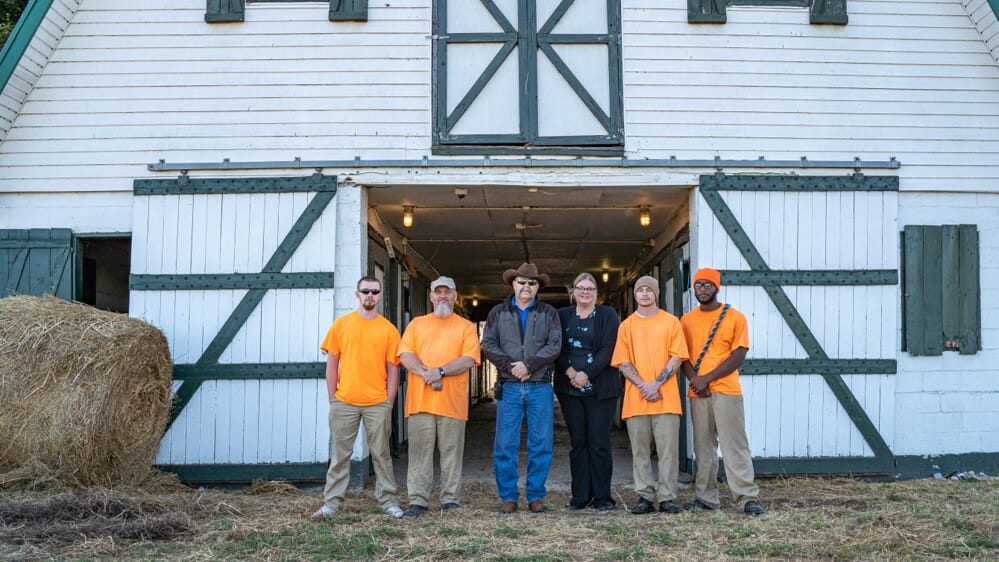We know that employment is one of the keys to reducing recidivism. But there hasn’t been a strong connection between the business community and Department of Corrections when you’re talking about the reentry population. It doesn’t make sense when that’s one of the major factors of keeping those formerly incarcerated from going back into prison. So, why have these two entities not been strategically linked previously? This program is an important step in that direction. – Laurie Mays, equine and agriculture talent pipeline project manager, Kentucky Chamber Foundation Workforce Center
Equine industry's economic impact
The Challenge
Horses are a big deal in Kentucky. With more than 1,100 horse farms, the equine industry contributes an estimated 60,000 jobs and $6.5 billion of direct and indirect economic impact to the Bluegrass State.
But the equine industry—which includes thoroughbred and show horse farms, veterinary clinics, race tracks, and equine transportation businesses—has suffered from major labor shortages that limit growth. Historically, this has been a very family-oriented business with most staff coming from those who have grown up in the industry. But as fewer people are exposed to agriculture as a way of life, young people are unaware of these career opportunities, and the physical nature of working with horses is unappealing to many.
The lack of grooms, exercise riders, and hot walkers, for example, seriously reduces the number of horses a thoroughbred trainer can handle, limiting the size of the business. To address this critical workforce problem, the Kentucky Equine Education Project (KEEP) partnered with the Kentucky Chamber of Commerce Foundation Workforce Center to launch an equine initiative. Like the efforts spearheaded by the Workforce Center in other industries, the equine employer collaborative uses the U.S. Chamber of Commerce Foundation’s Talent Pipeline Management® (TPM) framework. By applying the TPM framework, the industry’s pain points came into focus (TPM Strategy 1), along with the demand projections for their most critical roles (TPM Strategy 2) and specific skills needed (TPM Strategy 3).
The Solution
In deciding on which solutions to implement to solve the worker shortage, one approach that gained increasing interest was engaging opportunity talent. Based on existing relationships and programs, a natural starting place was with those with a justice-involved background. Kentucky’s Department of Corrections suggested that the collaborative explore the Thoroughbred Retirement Foundation’s (TRF) Second Chances program at Blackburn Correctional Facility as a potential source of talent (TPM Strategy 4). Qualified inmates participate in an eight-month program on TRF’s farm at the Blackburn facility, managing a herd of more than 50 retired racehorses. In addition to building life skills, participants learn to work with the horses one-on-one. They also take courses focusing on equine anatomy and physiology, basic nutrition, and first aid.
While the TRF program provided valuable experience for the participants while incarcerated, there was no formal strategy to help them find work in the industry after they were released. Led by Laurie Mays, equine and agriculture talent pipeline project manager at the Kentucky Chamber Foundation Workforce Center, the Thoroughbred Farm collaborative helped develop a robust Workforce Readiness and Reentry Program at Blackburn (TPM Strategy 5). This included mock interviews, and other capabilities equine employers considered necessary for promising job candidates.
Collaborative employers began coaching program participants on job search skills just before the COVID-19 pandemic hit in early 2020. When the prison stopped allowing visitors, the work went virtual with equine employers coaching participants through online video platforms.

Hiring Graduates of Blackburn’s
Second Chances Program
As employers learned more about the training at Blackburn, they recognized the value of creating a clear pathway to employment for participants in the prison’s program. To do so, Mays helped implement a communication process between the prison and the equine industry, so employers would be notified when a graduate was eligible for employment.
After delivering the Workforce Readiness Program virtually, it seemed only natural for equine employers to start remote job interviews with graduates. The first time the four initial hires met their new employer face-to-face was when they started on the job.
Transitioning to Second Chance Employment
Successfully hiring reentry workers means making sure they have the essential wrap-around services they need to stay employable. For example, when an inmate is nearing release, Blackburn’s reentry coordinator interviews the person to understand his interests and career goals. The coordinator also helps the returnee find safe housing, deal with transportation needs, and bank accounts—all the essentials of life outside of prison. A new employee without stable housing or reliable transportation is not going to stay on the job long.
Expanding the Impact of Second Chance’s Program
Involving employers directly in Blackburn’s Second Chances program has allowed the industry to give the equine instructor specific feedback about the types of skills businesses value most (TPM Strategy 3). TRF has equine training programs like the one at Blackburn in seven other prison facilities around the country, and thanks to this program’s success, they have asked Mays and her colleagues if they could help duplicate the process elsewhere.
Ultimately, Mays and her team also expect to expand the program into other regions and industries in Kentucky. The equine industry will always be an important benefactor of Blackburn’s reentry talent, but recent placements have demonstrated the potential to enhance the talent pipelines of other industries, such as construction and manufacturing.
Mays has developed a database to keep track of where Blackburn’s former program participants are hired. She wants to see if this data shows over time that having a meaningful career reduces recidivism and also expects it to reveal which industries are the best targets for second chance employment.
The equine reentry program has served as a pilot initiative, developing templates that can help employers from other industries get involved. The experiences of farms that have initially employed men from Blackburn has also taught Mays and her equine colleagues about the onboarding process needed to make reentry transitions successful. Developing a template for how to onboard new hires from the reentry population requires detailed and essential procedures needed for long-term success in tapping this underutilized talent pool.

“Starting with the equine industry’s employer collaborative, we’re creating a solid foundation to prepare people to enter the workforce in a viable career path,” says Mays. “And, depending on a returnee’s interest, what’s exciting is we now know who the key players need to be and who to connect them with. So, moving forward we can facilitate a successful transition with any individual into any industry.”
This case study was written by Dr. David DeLong of Smart Workforce Strategies. To learn more about the Blackburn Workforce Readiness and Reentry Program, click here.
